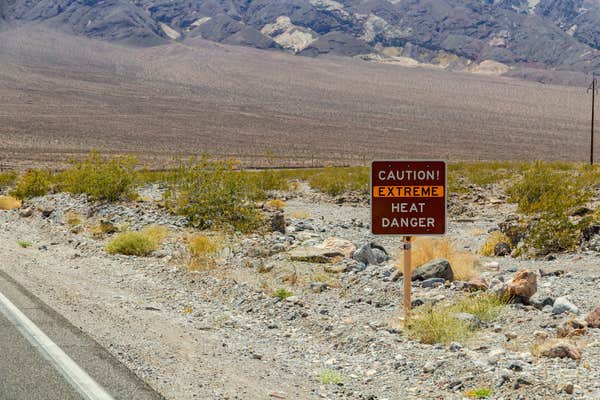Hey team, and welcome back to one5c! Every so often, I see a piece of climate research and immediately think “Well, they’re definitely gonna have fun with this.” The “they” there, if you didn’t guess, are climate deniers, delayers, and doomers. That’s what jumped into my brain earlier this month, when a major paper dropped in the journal Science and gave us one of the best views we’ve probably ever had at the history of Earth’s surface temperatures. If you just glance at the data on a chart, a couple things pop out—for instance, that the planet’s been way (way way) hotter than it is today.
The idea that “Earth’s always been hot” is among the most common gotcha! lines out there in conversations about human-caused climate change, so Sara Kiley’s gonna take the mic for today’s deeper dive to help y’all think your way through this most recent data dump. First, though, onto the week in the news. —Corinne
WHAT WE’RE INTO THIS WEEK
By Olivia Gieger

Built environment
Dream home or climate nightmare?
With every disaster, be it Hurricane Helene flooding the Southeast or major wildfires searing through Southern California, more American homes are facing the impacts of the climate crisis. Buyers are certainly aware: Some 80% say they are considering climate risks when shopping for a home, and insurance costs have jumped more than 20% over the last seven years. Now, the real-estate platform Zillow will include climate risk data on its listings, including information on wildfire, flood, wind, heat, and air quality risks, through a partnership with climate modeler First Street. Prospective buyers can expect to see the data on the site by the end of the year and in the app in 2025.
Accountability Check
How fossil fuel companies influence protest laws
As peaceful protesters and activism punctuated Climate Week events across New York City last week, The Guardian published an investigation revealing how fossil-fuel lobbyists have shaped harsher anti-protest laws in a number of U.S. states. The reporting uncovered emails dating back to 2017 in which lobbyists advocated for harsher punishments for those peacefully disrupting fossil-fuel infrastructure expansion. In one exchange in particular, a lobbyist pushed for trespassing charges to be upgraded into felonies. This influence, the reporting found, can be seen on 22 state laws across the U.S.
Good read
What’s the world look like if we ‘get it right’?
So much climate fiction and future-focused writing centers on dreary outcomes, but what if all our progress actually comes to fruition? Marine biologist and climate policy expert Ayana Elizabeth Johnson asks that question in her newly released second book, What If We Get It Right? Like her first anthology, All We Can Save, this one collects interviews, essays, poems, and art from other climate leaders and experts including author Bill McKibben and political scientist Rhiana Gunn-Wright. “I just want people to understand that we have the solutions we need. It’s implementation of those solutions that’s really not up to the pace that we need,” Johnson told PBS NewsHour.
Cause for optimism
Solar installations are outpacing predictions
Solar energy is on fire, even beyond what energy analysts forecasted. A new report from the think tank Ember found that global solar installations are up 29% from where they were at this time last year, thanks largely to increased efficiency and plummeting costs. The report says we’re on pace to hit 593 gigawatts of solar by the end of the year—200 gigawatts more than the International Energy Agency estimated at the start of the year. With aspirations to cut emissions to 50% of 1990 levels by 2030, this is the kind of pace and scale that is necessary, Canary Media reports. Another paper from the International Renewable Energy Agency offered similarly hopeful numbers: 75% of renewable energy capacity added to the grid in 2023 was cheaper for customers than fossil-fuel alternatives.
MIC-DROP CLIMATE STAT
50%
The portion of an electronic device’s lifetime emissions—including mining, manufacturing, and transportation of the product—that could be mitigated by extending its useful life by 50%–100%. Here’s our guide for keeping your phone kickin’ as long as possible.
STUDY GUIDE
The best look yet at our place in Earth’s hot history
By Sara Kiley Watson

Have you ever noticed that climate activists, policymakers, and journalists (present company included!) tend to say we’re working to save the “world” as opposed to the “planet”? Well, it’s true, and the reason is all about context. The planet, this mass of rock and water, can survive extreme heat. The world—today’s makeup of flora, fauna, and humans—on the other hand, won’t have an easy time. And a paper published earlier this month provides a deeper look at humankind’s place (and role) in the history of Earth’s existence.
The research, which appeared in the journal Science, is the most detailed look yet at Earth’s average temperature over the past 485 million years. Scrolling wayyyyy back in this way can give us clues as to what life here may be like in the distant future, and underscores the role we can play in shaping that future for humans and other species. Can the world as we know it survive? Outlook not so good.
Setting the scene here starts with a simple admission: Earth today isn’t that hot, planetarily speaking. The historic temperature peak was around 97 degrees Fahrenheit, while the average global temperature last year was 59. But in steamier times, the planet looked different, and so did the creatures that lived on it. Take the era known as the Paleocene-Eocene Thermal Maximum, which was around 55 million years ago: Back then, temperatures averaged around 78 degrees Fahrenheit. To beat the heat, mammals shrunk by around 30%, including for example the Sifrhippus sandae, the earliest known horse species, which dropped from an already tiny 12 pounds to 8.5. Reptiles at the same time grew even bigger; fossils from the time include snake vertebrae four times larger than today’s anacondas.
The moments when the temperature has risen rapidly tend to be the most disastrous for life on the planet. Earth’s largest mass extinction took place 250 million years ago when volcanic eruptions sent the mercury up 18 degrees Fahrenheit over the course of 50,000 years. Even though today’s average is starting at a lower point, the speed at which human-made carbon emissions have changed the climate over the last 200ish years makes that prehistoric jump look like a bunny slope. Since 1850, the global temperature has increased an average of 0.011 degrees Fahrenheit every year; back then the average annual jump was 0.00036 degrees. That pace is around 30 times faster, which doesn’t give living things enough time to adapt and survive.
“Our entire species evolved to an ‘ice house’ climate, which doesn’t reflect most of geological history,” study co-author Jessica Tierney, a paleoclimatologist and professor of geosciences at the University of Arizona, said in a recent press release. “We are changing the climate into a place that is really out of context for humans. The planet has been and can be warmer—but humans and animals can’t adapt that fast.”
Beyond temperature, this paper also confirmed an essential piece of information that’s key for understanding how our planet’s past fits into the world’s future: In all of those times where the Earth was especially toasty, the carbon dioxide levels in the atmosphere were high—and vice versa for lower temperatures coinciding with less CO2. The authors, in fact, label carbon dioxide “the dominant control on global temperatures across geological time.” The difference with today’s climb is that we know what’s causing it and, importantly, that it’s entirely possible to mitigate the worst to come.
